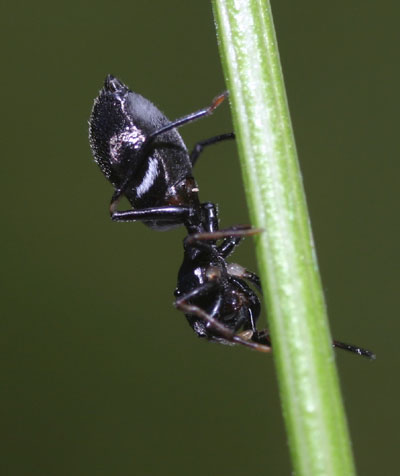 … if you thought this was an ant. That’s really the whole idea.
… if you thought this was an ant. That’s really the whole idea.
I spotted one of these in one of my regular insect-hunting spots, but only got a single inadequate photo of it before it vanished under some leaves. Earlier today, I spotted it again – this time, venturing under the web tent shelter of a crab spider, who vacated quickly at the threat; of course, my camera was not in hand for this drama. But after fetching it and a bit of searching, I managed to locate it again, and with a little more playing around, captured it in a film can (look it up, it’s alongside “rotary telephone”) and brought it in for questioning a photo session.
“But what is it?” you ask impatiently. “It is one of the more interesting manifestations of natural selection,” I say, grandly yet vaguely, mostly just to piss you off some more. But it’s still true – this is a Peckhamia americana, otherwise known as an antlike jumping spider, and the camouflage is remarkable. I may have gone past countless examples of these guys, since they’re fairly small and it takes a sharp eye to catch the subtle differences as they tool along the leaves and vines. A little tip, which applies to many different aspects of nature photography: behavior is often a good indication that something is not what it seems. I’ve pointed out before that one can tell a Sphingidae moth that mimics a bumblebee apart from a real bee very easily, since the bee always lands on the flower and the moth does not. In the case of antlike jumping spiders, they tend to pause and search more than ants, who typically move very directly and without hesitation. You might think the eight legs of the spider against the ant’s six would be a giveaway, but it actually takes sharp eyes to pick up this trait quickly, and the spider often waves its two forelegs around like antennae anyway.
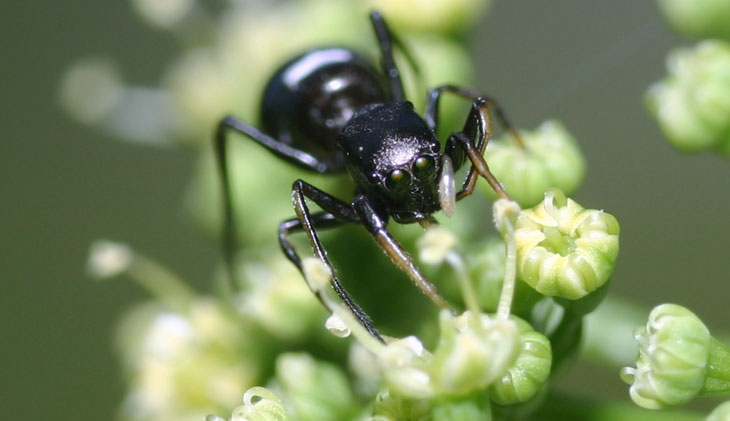
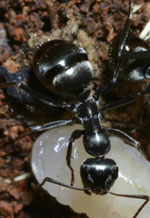 That’s a better view above, with another telltale, if you can get a close enough look. Ants, like the one at left, have a separate head on an articulated neck, while spiders have a combined head and torso called a cephalothorax, a great word to drop at parties. Plus those eyes are very indicative of jumping spiders – in fact, the eye layout is one way in which arachnologists tell the classes of spiders apart. But you’re probably more likely to be seeing such a critter from directly overhead, which means the eyes won’t be visible. So, another trait that may help is seeing the activity of the pedipalps, the extra little ‘legs’ that spiders have alongside their chelicerae (fangs.) These are often used to feel their way and can be seen drumming busily as the spider ventures onwards.
That’s a better view above, with another telltale, if you can get a close enough look. Ants, like the one at left, have a separate head on an articulated neck, while spiders have a combined head and torso called a cephalothorax, a great word to drop at parties. Plus those eyes are very indicative of jumping spiders – in fact, the eye layout is one way in which arachnologists tell the classes of spiders apart. But you’re probably more likely to be seeing such a critter from directly overhead, which means the eyes won’t be visible. So, another trait that may help is seeing the activity of the pedipalps, the extra little ‘legs’ that spiders have alongside their chelicerae (fangs.) These are often used to feel their way and can be seen drumming busily as the spider ventures onwards.
Now, another little thing to make your pursuit of photos a wee bit easier. While nice natural-looking settings can do a lot for your photos, most insects are not so cooperative that they’ll do what you say, pause, and pose as needed. In fact, I may be going out on a limb here, but I don’t think they ever do. If you’re quick, you can catch some shots on the fly, but in circumstances like this where you want photos of a particular hard-to-find subject, this could actually drag out the quest for decent photos, literally, over years. So, we can cheat a little, and create a very simple set, one that doesn’t allow our subjects too much opportunity to scamper off and hide. Behold the bug moat.
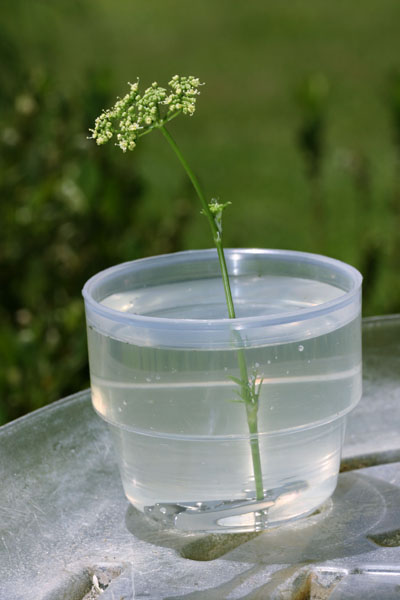 Yep, just a small cup of water, and something to hold a natural plant or branch upright in the center – I’ve used a couple of alligator clips here. The range that the arthropod can move is very limited, with few places to hide, and the water prevents an escape, or at least a quick one. The cup can even be moved for a better background, or rotated to take advantage of lighting conditions (as well as keeping your subject facing the camera.) Just keep leaves and branches away from the edges to help prevent escapes. By limiting the range and options of your subject, you can obtain better shots in a shorter period of time, and not tear your hair out in frustration unless you really want to (far be it from me.) This is hardly innovative, but sometimes it’s the simple things that make your tasks much easier.
Yep, just a small cup of water, and something to hold a natural plant or branch upright in the center – I’ve used a couple of alligator clips here. The range that the arthropod can move is very limited, with few places to hide, and the water prevents an escape, or at least a quick one. The cup can even be moved for a better background, or rotated to take advantage of lighting conditions (as well as keeping your subject facing the camera.) Just keep leaves and branches away from the edges to help prevent escapes. By limiting the range and options of your subject, you can obtain better shots in a shorter period of time, and not tear your hair out in frustration unless you really want to (far be it from me.) This is hardly innovative, but sometimes it’s the simple things that make your tasks much easier.
Another thing that’s actually handy is just a business card or small piece of paper. With tiny insects or arachnids like this, it’s really not possible to grasp them, even with forceps of tweezers, so you slip something under them instead. My subject here, for some reason, thought my hand was much more interesting than any leaf or branch I presented, and twice I spent more time than I thought should have been necessary coaxing him off of me and onto a “setting.”
Going back to the antlike jumping spider, consider that the species arrived at this appearance over thousands of generations. Every time an individual spider was born looking just a little more like an ant, its natural predators (who found ants less tasty) tended to pass it over a little more often than the members of the same species who didn’t look like ants. So the ones that did gained reproductive advantage, simply by surviving a little bit longer, and those genetic tendencies passed along. Gradually, the spider took on a close resemblance to ants, a passive resistance to predation – some species even live in close proximity to ants and gain benefit from the ant colonies directly – near as I can tell, my subject here is not one of them, since I have seen none anywhere near the numerous ant colonies in the yard.
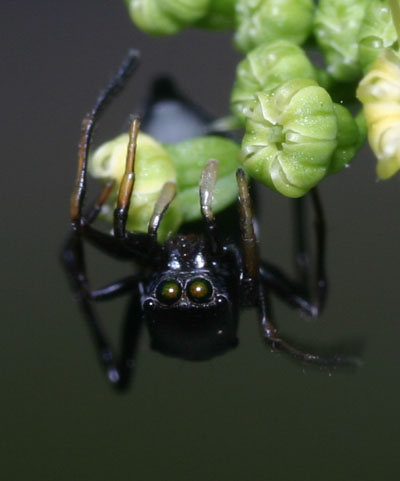 I’ll leave you with one last image, simply because I love the color cast in the eyes. The pedipalps are plainly visible here as the innermost ‘legs,’ but note the motion blur of the one midleg, which occurred despite the 1/200 second shutter speed I was using. Quick little bugger – which means you now know why I wanted to limit its movement. Overall length was perhaps 6mm – it didn’t seem inclined to hold still long enough for me to slide a scale alongside. When I figure out how to accomplish that more dependably, I’ll pass that along too.
I’ll leave you with one last image, simply because I love the color cast in the eyes. The pedipalps are plainly visible here as the innermost ‘legs,’ but note the motion blur of the one midleg, which occurred despite the 1/200 second shutter speed I was using. Quick little bugger – which means you now know why I wanted to limit its movement. Overall length was perhaps 6mm – it didn’t seem inclined to hold still long enough for me to slide a scale alongside. When I figure out how to accomplish that more dependably, I’ll pass that along too.
















































